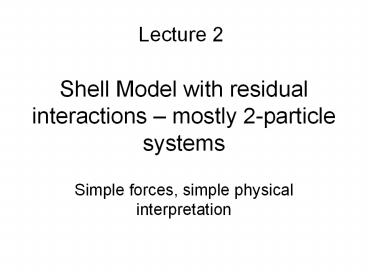Shell Model with residual interactions - PowerPoint PPT Presentation
Title:
Shell Model with residual interactions
Description:
Lecture 2 Shell Model with residual interactions mostly 2-particle systems Simple forces, simple physical interpretation Independent Particle Model Some great ... – PowerPoint PPT presentation
Number of Views:80
Avg rating:3.0/5.0
Title: Shell Model with residual interactions
1
Shell Model with residual interactions mostly
2-particle systems
Lecture 2
- Simple forces, simple physical interpretation
2
Independent Particle Model
- Some great successes (for nuclei that are doubly
magic plus or minus 1). - Clearly inapplicable for nuclei with more than
one particle outside a doubly magic core. In
fact, in such nuclei, it is not even defined.
Thus, as is, it is applicable to only a couple
of nuclei.
3
IPM cannot predict even these levels schemes of
nuclei with only 2 particles outside a doubly
magic core
4
(No Transcript)
5
IPM too crude. Need to add in extra interactions
among valence nucleons outside closed shells.
These dominate the evolution of Structure
- Residual interactions examples of simple forms
- Pairing coupling of two identical nucleons to
angular momentum zero. No preferred direction in
space, therefore drives nucleus towards spherical
shapes - p-n interactions generate configuration mixing,
unequal magnetic state occupations, therefore
drive towards collective structures and
deformation - Monopole component of p-n interactions generates
changes in single particle energies and shell
structure
6
So, we will have a Hamiltonian H H0
Hresid.where H0 is that of the Ind. Part.
ModelWe need to figure out what Hresid.
does.Since we are dealing with more than one
particle outside a doubly magic core we first
need to consider what the total angular momenta
are when the individual ang. Mon. of the
particles are vector-coupled.
7
Coupling of two angular momenta
j1 j2 All values from j1 j2 to
j1 j2 (j1 j2) Example j1 3, j2 5 J
2, 3, 4, 5, 6, 7, 8 BUT For j1 j2 J
0, 2, 4, 6, ( 2j 1) (Why these?)
/
8
How can we know which total J values are obtained
for the coupling of two identical nucleons in the
same orbit with total angular momentum j?
Several methods easiest is the m-scheme.
9
(No Transcript)
10
Can we obtain such simple results by considering
residual interactions?
11
Separate radial and angular coordinates
12
(No Transcript)
13
(No Transcript)
14
(No Transcript)
15
How can we understand the energy patterns that
we have seen for two particle spectra with
residual interactions? Easy involves a very
beautiful application of the Pauli Principle.
16
(No Transcript)
17
x
18
This is the most important slide understand this
and all the key ideas about residual interactions
will be clear !!!!!
19
(No Transcript)
20
R4/2lt 2.0
21
(No Transcript)
22
(No Transcript)
23
(No Transcript)
24
(No Transcript)
25
(No Transcript)
26
(No Transcript)
27
(No Transcript)
28
Extending the Shell Model to 3-particle sysetms
- Consider now an extension of, say, the Ca nuclei
to 43Ca, with three particles in a j 7/2 orbit
outside a closed shell? - How do the 3 - particle j values couple to give
final total J values? - If we use the m-scheme for 3 particles in a 7/2
orbit, the allowed J values are 15/2, 11/2, 9/2,
7/2, 5/2, 3/2. - For the case of J 7/2, two of the particles
must have their angular momenta coupled to J 0,
giving a total J 7/2 for all three particles. - For the J 15/2, 11/2, 9/2, 5/2, and 3/2, there
are no pairs of particles coupled to J 0. - What is the energy ordering of these 6 states?
Think of the 2-particle system. The J 0 lies
lowest. Hence, in the 3-particle system, J 7/2
will lie lowest.
29
Think of the three particles as 2 1.
How do the 2 behave? We have now seen that they
prefer to form a J 0 state.
30
43Ca
Treat as 20 protons and 20 neutrons forming a
doubly magic core with angular momentum J 0.
The lowest energy for the 3-particle
configuration is therefore J 7/2. Note that
the key to this is the result for the 2-particle
system !!
31
(No Transcript)
32
(No Transcript)
33
(No Transcript)
34
Multipole Decomposition of Residual Interactions
We have seen that the relative energies of
2-particle systems affected by a residual
interaction depend SOLELY on the angles between
the two angular momentum vectors, not on the
radial properties of the interaction (which just
give the scale). We learn a lot by expanding the
angular part of the residual interaction,
Hresidual V(q,f) in spherical harmonics or
Legendre polynomials.
35
(No Transcript)
36
(No Transcript)
37
(No Transcript)
38
(No Transcript)
39
Probes and probees
40
(No Transcript)
41
(No Transcript)
42
(No Transcript)
43
(No Transcript)
44
(No Transcript)
45
Two mechanisms for changes in magic numbers and
shell gaps
- Changes in the single particle potential occurs
primarily far off stability where the binding of
the last nucleons is very weak and their wave
functions extend to large distances, thereby
modifying the potential itself. - Changes in single particle energies induced by
the residual interactions, especially the
monopole component.

